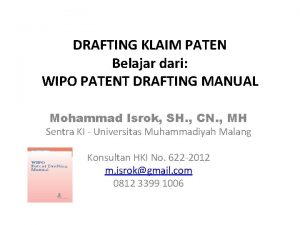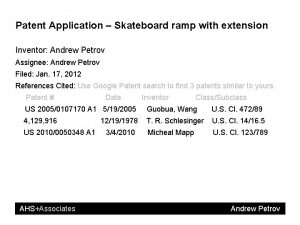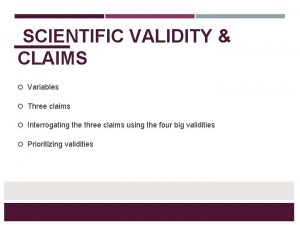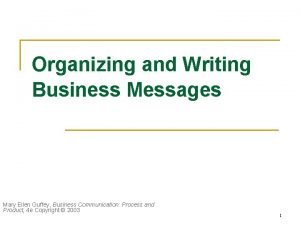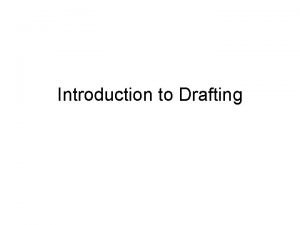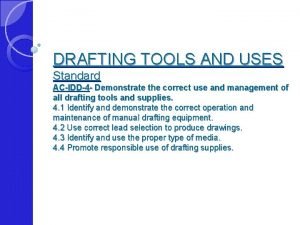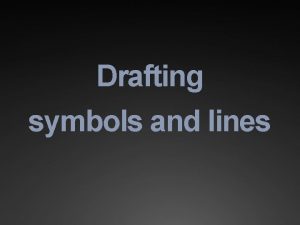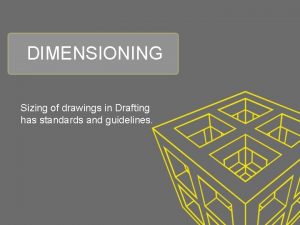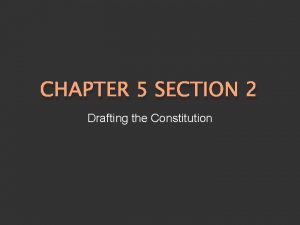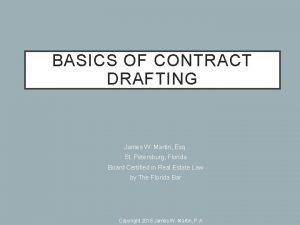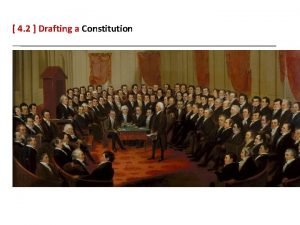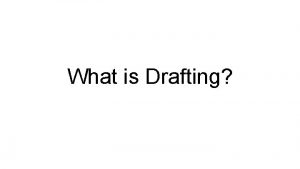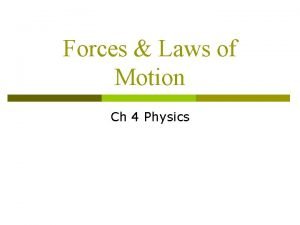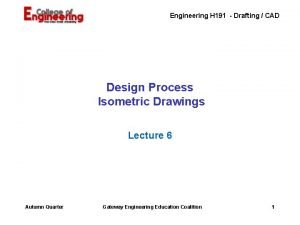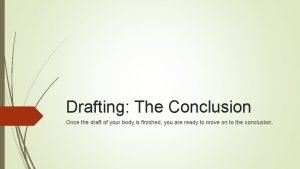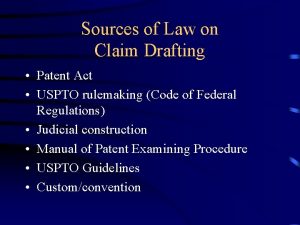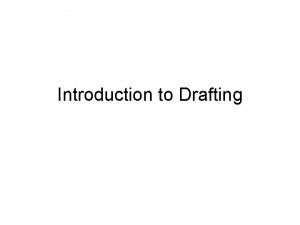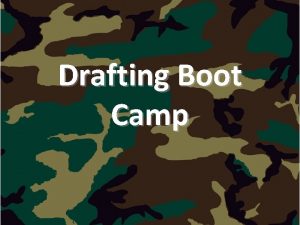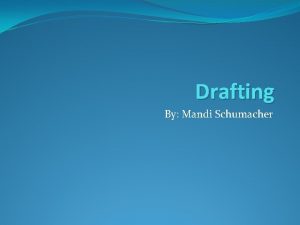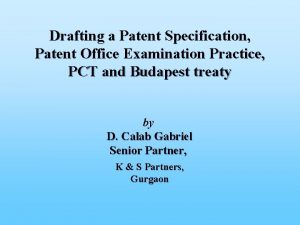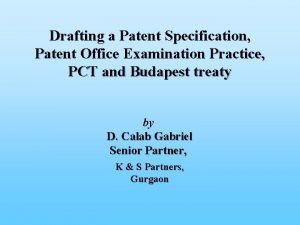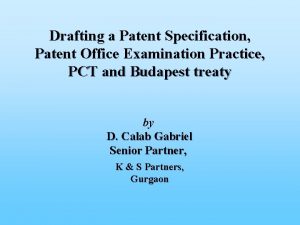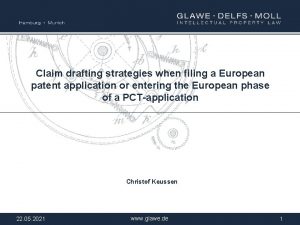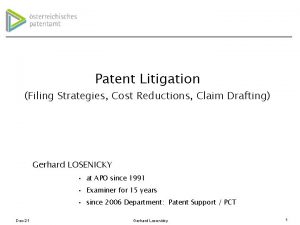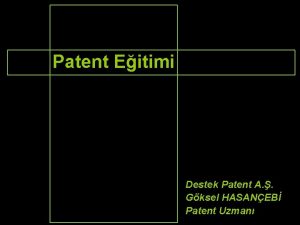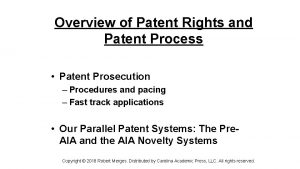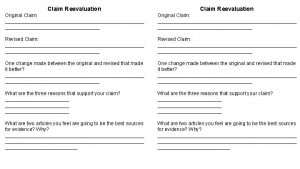Patent Law 8 24 04 Claim Drafting Claim


























![[T]he district court was correct to look to the ordinary meaning of the terms [T]he district court was correct to look to the ordinary meaning of the terms](https://slidetodoc.com/presentation_image/04980264e236e59c8e4c2c8113ea9491/image-27.jpg)


- Slides: 29

Patent Law 8. 24. 04 Claim Drafting

Claim Scope 101 • What is the goal? – Maximize “SHELF SPACE” you own • How do you get there? – By drafting broadest claim(s) possible


More space, more $$!

P. 46: “A cupholder comprising a strip of insulating material, said strip having two ends capable of interlocking to form a band for receiving a cup. ”

P. 36: “A cup holder comprising a band of insulating material. ”

“Less is More” Short, broad claim Corrugated paper strip w/ “slotted” closure Styro strip w/ velcro closure

“Less is More” Narrower, longer claim Corrugated paper strip w/ “slotted” closure Styro strip w/ velcro closure

Dealing with Prior Art • Multiple claims – More variations in scope, more chances to own the key piece of shelf space – More chances that at least one claim will end up valid and valuable • Disclosure, searches, prosecution – A complex calculus governs searching for and including prior art – Willfull infringement/inequitable conduct

“picture claim” Broadest Claim (Claim 1)

“Less is More” (Enforceable) ‘ 473 Coffin Sr. – tubular preformed Narrower, longer claim Corrugated paper strip w/ “slotted” closure Noon prior art holder



The “Noon” Patent – p. 44

• United States Patent 5, 425, 497 Sorensen June 20, 1995 Cup holder • Abstract • A cup holder is disclosed in the form of a sheet with distal ends. A web is formed in one of the ends, and a corresponding slot is formed in the other end such that the ends interlock. Thus the cup holder is assembled by rolling the sheet and interlocking the ends. The sheet can be an elongate band of pressed material, preferably pressed paper pulp, and is preferably formed with multiple nubbins and depressions. In one embodiment, the sheet has a top and bottom that are arcuate and concentric, and matching webs and cuts are formed in each end of the sheet, with the cuts being perpendicular to the top of the sheet. • Inventors: Sorensen; Jay (3616 NE. Alberta Ct. , Portland, OR 97211) Appl. No. : 150682 Filed: November 9, 1993




Narrowing Amendment

United States Court of Appeals for the Federal Circuit 04 -1097 INNOVA/PURE WATER, INC. , Plaintiff-Appellant, v. SAFARI WATER FILTRATION SYSTEMS, INC. (doing business as Safari Outdoor Products), Defendant-Appellee.


Safari's accused product is a water bottle with a tube of filtering material, a bottle cap, and a valve. In operation, the tube of filtering material is suspended in the mouth of the bottle by means of an annular flange that rests on the mouth of the bottle. The tube of filtering material is mechanically sealed in position when the bottle cap is screwed over the mouth of the bottle, thereby contacting the annular flange and fixing the tube of filtering material in position to filter water before it exits the bottle.

In part, the independent claims at issue in the '759 patent state: 1. A filter assembly for use with a bottle having a circular cross-section neck or open end to simultaneously cap the neck or open end and filter liquid poured out of the bottle through the neck or open end, comprising: a tube of filtering material. . . a cap. . . said cap having first and second substantially opposite surfaces. . . a manual valve operatively associated with said cap, in fluid communication with said tube of filtering material and manually movable between a position defining means for allowing liquid flow through said tube and a position defining means not allowing liquid flow through said tube; and said tube operatively connected to said cap second surface at said tube second open end. .

The district court construed the claim term "operatively connected" to require that the tube of filtering material be affixed to the cap, i. e. , "not merely adjoining or abutting, but affixing the tube to the cap by some tenacious means of physical engagement that results in a unitary structure. "

Concluding that the annular flange arrangement of Safari's accused product is such that the filter tube is "never affixed to the cap by some tenacious means of physical engagement as required by claims 1 and 15, " the district court denied Innova's motion for summary judgment and granted Safari's motion for summary judgment of noninfringement.

The district court erred. The asserted claims do not require that the filter tube and cap be affixed to one another in a manner that results in the two components forming a unitary structure.
![The district court was correct to look to the ordinary meaning of the terms [T]he district court was correct to look to the ordinary meaning of the terms](https://slidetodoc.com/presentation_image/04980264e236e59c8e4c2c8113ea9491/image-27.jpg)
[T]he district court was correct to look to the ordinary meaning of the terms "operatively" and "connected" and we discern no error in the district court's initial understanding that "the ordinary and customary meaning of 'operatively connected' requires the. . . linking together of the tube and the cap to produce the intended or proper effect. "

But the district court erred when it proceeded beyond this plain meaning based on the "[e]xamples of means for connecting the tube to the cap disclosed in the '759 patent, " all of which reflect a "physical engagement [between the tube and the cap] that results in a unitary structure. "

Specification Examples • See p. 40, col 4 – Reversible band – Band plus cup combination
 Patent claim drafting exercises
Patent claim drafting exercises Wipo patent drafting manual
Wipo patent drafting manual Patent attorney side business drafting drawings
Patent attorney side business drafting drawings Claim of policy essay examples
Claim of policy essay examples Hot topics in patent law
Hot topics in patent law Newton's first law and second law and third law
Newton's first law and second law and third law Si unit of newton's first law
Si unit of newton's first law V=k/p
V=k/p Charles law constant
Charles law constant 3 claims 4 validities
3 claims 4 validities Claim-counterclaim
Claim-counterclaim How do you write a counterclaim paragraph
How do you write a counterclaim paragraph The writing process drafting
The writing process drafting Example of academic text
Example of academic text Legislative drafting software
Legislative drafting software Objective of drafting
Objective of drafting Introduction of drafting
Introduction of drafting Create a flipbook of drafting materials tools equipment
Create a flipbook of drafting materials tools equipment Drafting symbols
Drafting symbols Superimposed dimensioning
Superimposed dimensioning Chapter 5 section 2 drafting the constitution
Chapter 5 section 2 drafting the constitution Drawing codes in technical drawing
Drawing codes in technical drawing Contract drafting basics
Contract drafting basics Drafting technical drawing
Drafting technical drawing The new jersey plan
The new jersey plan What is drafting
What is drafting A student attaches a rope to a 20 kg box of books
A student attaches a rope to a 20 kg box of books Visible line example
Visible line example Conclusion of drafting
Conclusion of drafting Drafting community
Drafting community

